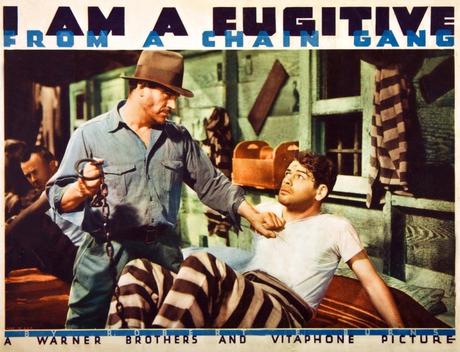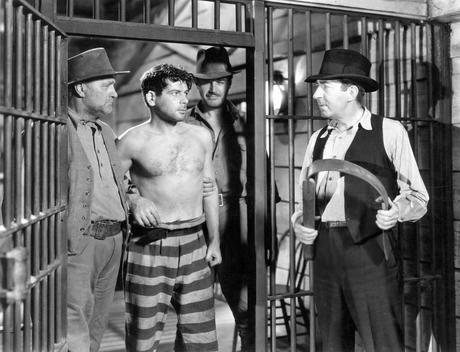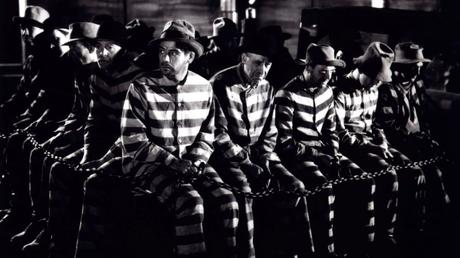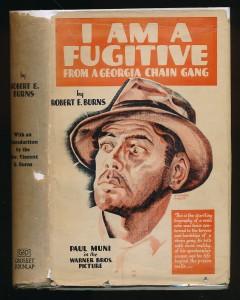
Over the years, there has been no shortage of books being turned into movies. However, I Am a Fugitive from a Georgia Chain Gang!, along with its subsequent film adaptation, 1932’s I Am a Fugitive from a Chain Gang have the distinction of being widely credited with bringing about social change by leading to the end of the chain gang system.
I Am a Fugitive from a Georgia Chain Gang! was the autobiographical story of Robert Elliott Burns, a World War I veteran who was unable to return to the job he had before the war and had few other job prospects after the war. While moving around looking for work, he was an unwilling participant in a grocery store robbery in which he, along with two other men, only got $5.80. The three men were arrested and Burns was sentenced to 6-10 years on a chain gang in Georgia, where he witnessed and experienced inhumane treatment. Burns later devised a plan to escape and made his way to Chicago, where he became a prominent member of the community. While in Chicago, he was pressured into marrying a woman he didn’t really love. But when he wanted a divorce to marry someone else, his wife alerted the authorities to his whereabouts. Despite having a lot of support from some very influential people, he ended up going back to Georgia to serve out more of his sentence. He had been promised an easy sentence with a quick pardon. Instead, he ended up back doing hard labor alongside criminals that other prisons had deemed too difficult. When it became clear that the state of Georgia had no intention of upholding their agreement, he made a second successful escape attempt.

Book & Movie Differences
Over the years, I’ve read some articles about I Am a Fugitive from a Chain Gang which described the movie as being pretty faithful to the book. After reading the book, I feel like those statements were perhaps a little bit generous. For the most part, the movie is a pretty good adaptation and the key events from the book did make it in. Even some of the moments that you might think were dramatic embellishments created by a screenwriter actually were things that were mentioned in the book. For example the part about Burns going unrecognized while getting a shave in a barber shop was based on Burns’ own account. As was the part where Burns is terrified to board a train because he sees police are looking for someone, only for the police to nab another man instead.
However, it’s easy to understand why some changes had to be made. There’s no way around the fact that the original story, as it was told by Robert Elliott Burns in his book, contains a lot of material that was inevitably going to be difficult to get past censorship guidelines that existed at the time.
To start with, note that the state of Georgia is mentioned in the title of the book, but is not mentioned in the movie title — or even in the movie at all. In an effort to avoid offending theater owners in the southern United States, the movie did not mention a specific location for the chain gang. But that ultimately didn’t stop the state of Georgia and two prison wardens from Georgia from filing lawsuits against Warner Brothers over the movie. It didn’t prevent the movie from being banned in Georgia, either.
Not only did Warner Brothers need to try to appease southern theater owners and moviegoers, there was the fact that portraying government officials as corrupt was frowned upon. In the movie version, it’s said that there are only two ways for someone to get off of the chain gang: either finish out your sentence or die. In the book, Burns states that there was a third option: to buy yourself a pardon. Burns wrote about how it was understood that the people in charge of deciding pardons weren’t paid very well so if you wanted a pardon, some kind of financial compensation was expected.

While many changes are understandable given the era I Am a Fugitive from a Chain Gang was made in, there are some changes that seem to have been made solely for dramatic effect. Robert’s first escape attempt in the movie is basically how it is described in the book — he convinces a fellow prisoner to hit his shackles with a hammer to bend them so that he can slip them off his feet. On the other hand, his second escape attempt is very heavily embellished. In the book, he talked about how he paid a local man to drive him away as he got away from the chain gang. No explosives were involved like you see in the movie.
I Am a Fugitive from a Chain Gang is well-known for its powerful ending where Robert is reunited with his girlfriend, Helen, after his second escape. Even though this meeting is brief and intended as a farewell, it feels like more closure than Robert Burns actually got with the woman he had wanted to divorce his wife for. His girlfriend had moved to Georgia to be closer to the prison where Robert was being held and had tried to be supportive. But after his second escape, Robert made an effort to contact her and briefly reached her once, but was never able to contact her again after that.
The movie also leaves out or changes some notable details that were discussed in the book. In the movie, it shows Robert actively rejecting his old, pre-war job so that he can pursue something new. In reality, he had tried to get his old job back, but he couldn’t and any jobs he could find didn’t come close to paying what he had been earning before the war. The movie also does not touch on the fact that Robert Burns dealt with PTSD after returning from the war. While living in Chicago after his first escape, Robert became a landlord before eventually starting a magazine whereas the movie shows him as getting into construction. The book also covers a little bit of Robert’s life after his second escape. The story of Robert Elliott Burns was also depicted in the 1987 movie The Man Who Broke 1,000 Chains starring Val Kilmer, which does include some of the details which were cut out or changed for I Am a Fugitive from a Chain Gang.
Is the Book Worth Reading?

I’ve long been a big fan of I Am a Fugitive from a Chain Gang because of its gripping, hard-hitting style. I was not disappointed to find out that the book version was equally captivating. I had a hard time putting this book down. Even though the movie is pretty faithful to the book, I loved being able to hear the story directly from Robert’s point of view. I also really appreciated the extra context Burns provides in the book that wasn’t reflected in the movie. He gets into a lot of very specific detail about just how brutal and inhumane the treatment he and other prisoners received, often arbitrarily. It’s very easy to understand why this story caused such a sensation.
This review is part of the 2023 Classic Film Summer Reading Challenge hosted by Out of the Past. For more reviews on books related to classic film, be sure to follow the #ClassicFilmReading hashtag on social media.
